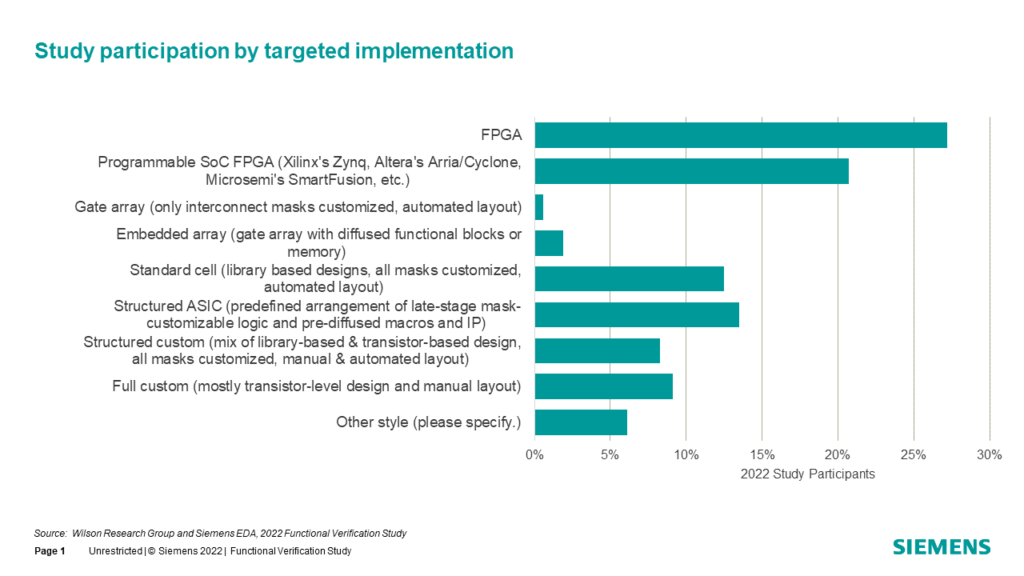Prologue: The 2022 Wilson Research Group Functional Verification Study

This is the first in a sequence of blogs that presents the findings from our new 2022 Wilson Research Group Functional Verification Study. Similar to my previous 2020 Wilson Research Group functional verification study blog series, I plan to separate the discussion by FPGA and IC/ASIC findings.
Study Overview
The study results presented in this blog series are a continuation of a series of industry studies on functional verification that began in 2007 and continued biennially starting in 2010. Each of these studies was modeled after the 2002 and 2004 Collett International Research, Inc. studies and focuses on the IC/ASIC market. While we began studying the FPGA market in 2012, we waited until we had sufficient multi-year data points to identify verification trends to draw any significant conclusions.
For the purpose of our study, a randomized sampling frame was constructed from multiple acquired industry lists. This enabled us to cover all regions of the world and all relevant electronics industry market segments. It is important to note that we did not include our own account teams’ customer lists in the sampling frame. This was done in a deliberate attempt to prevent vendor bias in the final results. While we architected the study in terms of questions and then compiled and analyzed the final results, we commissioned Wilson Research Group to execute our study. After data cleaning the results to remove inconsistent, incomplete, or random responses, the final sample size consisted of 980 eligible participants (i.e., n=980).
Confidence Interval
Since all survey-based studies are subject to sampling errors, we attempt to quantify this error in probabilistic terms by calculating a confidence interval. For our study, we determined the overall margin of error to be ±3.7% using a 95% confidence interval. In other words, this confidence interval tells us that if we were to take repeated samples from a population, 95% of the samples would fall inside our margin of error ±3.7%, and only 5% of the samples would fall outside.
Study Participants
In this section, I provide background information on the makeup of the study.
Figure 1 shows the percentage of 2022 study participants (i.e., design projects) by targeted implementation for both IC/ASIC and FPGA projects. Targeted implementation does not represent silicon volume in terms of the global semiconductor market since a single project could account for a significant portion of semiconductor market revenue.

Our 2022 Wilson Research Group study is a worldwide study, and Figure 2 shows the demographics by various regions of the world. The survey results are compiled both globally and regionally for analysis. In this blog sequence, we will present the global trends.

Figure 3 shows the percentage of overall study FPGA and IC/ASIC participants by market segment. This figures does not represent silicon volume by market segment.

Figure 4 shows the percentage of overall study eligible FPGA and IC/ASIC participants by their job description. An example of eligible participant would be a self-identified design or verification engineer, or engineering manager, who is actively working within the electronics industry. Overall, design and verification engineers accounted for a majority of the study participants, which is important to our study.

In my 2020 functional verification study blog series, I discussed general bias concerns associated with all survey-based studies and what we did to mitigate these concerns. This blog is still relevant and applies to our 2022 study. For more information, see Understanding and Minimizing Study Bias.
Quick links to the 2022 Wilson Research Group Study results
- Prologue: The 2022 Wilson Research Group Functional Verification Study
- Part 1 – FPGA Design Trends
- Part 2 – FPGA Verification Effectiveness Trends
- Part 3 – FPGA Verification Effort Trends
- Part 4 – FPGA Verification Effort Trends (Continued)
- Part 5 – FPGA Verification Technology Adoption Trends
- Part 6 – FPGA Verification Language and Library Adoption Trends
- Part 7 – IC/ASIC Design Trends
- Part 8 – IC/ASIC Resource Trends
- Part 9 – IC/ASIC Verification Technology Adoption Trends
- Part 10 – IC/ASIC Language and Library Adoption Trends
- Part 11 – IC/ASIC Power Management Trends
- Part 12 – IC/ASIC Verification Results Trends
- Conclusion: The 2022 Wilson Research Group Functional
- Epilogue: The 2022 Wilson Research Group Functional


